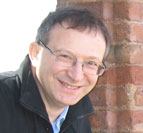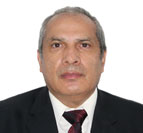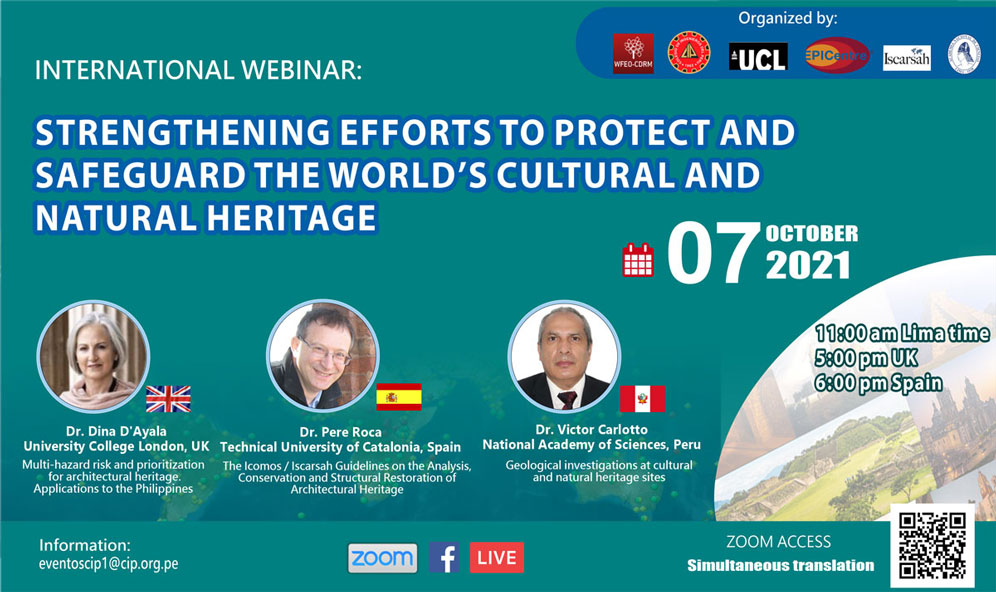The Committee on Disaster Risk Management of the World Federation of Engineering Organizations (WFEO-CDRM), the Peruvian Engineers Association (CIP), the University College London (UCL), the EPICentre, the International Scientific Committee on the Analysis and Restoration of Structures of Architectural Heritage (ISCARSAH) and the National Academy of Sciences of Peru have joined forces to organize the international webinar «STRENGTHENING EFFORTS TO PROTECT AND SAFEGUARD THE WORLD’S CULTURAL AND NATURAL HERITAGE», to be held on Thursday, October 7 at 11: 00 am, Lima, Peru time.
This important event will bring together leading specialists to present and discuss the resistance, stability and conservation of monumental heritage pieces within the framework of the triangle: environment – engineering/architecture – risk management. The environment includes both resources (available materials, quality) and severe hazards (earthquakes, floods, hurricanes, volcanic eruptions) and slowly degrading conditions (desertification, water table fluctuations, sea level rise or others related to climate change). In the field of engineering/architecture, the design of buildings and techniques that have allowed the conservation of monuments for a long time are considered. Finally, risk management deals with the measures that are or will be used to maintain the good condition of buildings.
The objectives of the event are: to expand and integrate knowledge that contributes to the conservation of cultural and natural heritage, as well as to promote the best techniques and procedures in the protection of cultural and natural heritage.
Professionals and students of engineering and architecture are invited to participate in the event, as well as cultural scholars: archaeologists and historians, scientists and risk managers, and those interested in world heritage in general.
The event will be conducted in English, with simultaneous translation into Spanish.
OUR SPEAKERS

Dr. Dina D’Ayala |
Multi-hazard risk and prioritization for architectural heritage. Applications to the Philippines |
| Architectural heritage and historic buildings are exposed through their life to natural hazards which often they were not designed to withstand. Such events can affect their cultural value, impair their use or even seriously damage their structures. With increased effects associated to climate changes, such hazardous events are becoming more recurrent and therefore aging heritage structures are increasingly being exposed to such risks, caused by different hazards, such as windstorms, earthquake and flooding. We therefore present a qualitative procedure for ranking the vulnerability of large portfolios of heritage structures to these hazards. We then introduce a novel unified numerical approach to model the fragility of masonry structures to lateral loading caused by different hazards. This homogenised technique allows to identified the greatest comparative risk for a given site and determine best preventive solutions. These procedures are illustrated with an application to heritage structures in the Philippines. | |
| Dina D’Ayala is Professor of Structural Engineering in the Department of Civil Environmental and Geomatic Engineering, at University College London UK. She is Head of Civil Engineering and Co-director of EPICentre. Prof D’Ayala specialism is Structural Resilience Engineering with particular emphasis on assessment, strengthening, preservation and resilience of buildings, structures, transport infrastructure and cultural heritage exposed to natural hazards, with focus on ODA countries. She has 30 years’ experience working with international agencies and heritage institutions. From 2016, she is Chief Scientist on the World Bank Global Programme for Safer Schools, producing the Global Library of School Infrastructure (GLOSI) and advising on school infrastructure resilience in Philippines, Salvador, Dominican Republic and Pakistan. She is a Director of the International Association of Earthquake Engineering and a founding member of ICOMOS-ISCARSAH. She has recently been awarded a UNESCO Chair in Disaster Risk Reduction and Resilience Engineering. She is the author over 300 refereed journals’, conference papers, books and book chapters, and she has supervised to completion more than 30 PhD students. | |

Dr. Pere Roca |
The Icomos / Iscarsah Guidelines on the Analysis, Conservation and Structural Restoration of Architectural Heritage |
| The ICOMOS / ISCARSAH Guidelines for the Analysis, Conservation and Structural Restoration of Architectural Heritage, now in development, will be presented and discussed. The International Scientific Committee on the Analysis and Restoration of Structures of Architectural Heritage (ISCARSAH) was founded by the International Council on Monuments and Sites (ICOMOS) in 1996 as a forum and scientific network of engineers, architects and scientists dealing with the structural dimension of monuments and historical constructions. The committee is oriented towards the study and the conservation of historical structures of cultural heritage buildings. The guidelines are intended to assist researchers and practitioners in the study of ancient structures across all its stages, including the investigation and documentation activities, the structural verification and the design of interventions. The ISCARSAH Guidelines have been written with the aim to provide guidance to the entire multidisciplinary teams involved in the study and conservation of historical structures. | |
| Pere Roca is professor of the Technical University of Catalonia, where he carries his activity as lecturer and researcher. His work focusses on non-destructive inspection techniques, structural monitoring, structural analysis and strengthening technologies. He has published more than 200 papers in conference proceedings and journals. He is co-editor of the International Journal of Architectural Heritage. He has been consultant in over 100 case studies, including 5 UNESCO World Heritage properties. He is a member of ICOMOS / ISCARSAH on Analysis and Restoration of Structures of Architectural Heritage, which he chaired from 2005 to 2008. | |

Dr. Víctor Carlotto |
Geological investigations at cultural and natural heritage sites |
| Three conservation experiences of these heritage sites are shown both at the time of occupation and at present. Machupicchu and Choquequirao were built in the Eastern Cordillera, with abrupt relief, unstable slopes and abundant rain. Here the Incas, based on their experience and their engineering, managed to control mass movements and give stability to the structures that have survived more than 500 years, and now they are being preserved with the conservation programs of Ministry of Culture-Cusco. The city of Caral, the most ancient urban settlement with monumental architecture in America, is located on the coast, where arid climate prevails. However, a lot of rain associated with El Niño phenomena, between 5000 and 4000 years BP produced several alluviums (debris floods) which affected this city during the occupation, and served as experience to try to control such floods. | |
| Geological Engineer from the University of Cusco. Postgraduate and doctorate in Earth Sciences (1998) at the University of Grenoble France. From 1982 to 2004 Professor and Researcher at the University of Cusco. From 2004 to 2014, Geoscientific Director and Director of Regional Geology at INGEMMET. From 2015 to July 2021, Principal Country Geoscientist Exploration Peru at BHP Billiton. 40 years of experience in geological exploration, including geological research in archaeological sites. From 2004 to 2008, member of the Scientific Committee of the UNESCO International Geosciences Program (IGCP). Since 2014 Full Member of the National Academy of Sciences of Peru. |



